Step-by-step instructions for beginner vegetable growers: how to grow cucumbers on the balcony and get a harvest
If you don’t have a summer cottage, you can always use the balcony to grow your favorite vegetables. Cultivating cucumbers at home is an excellent option for those who want to get a harvest of healthy fruits in winter. All that is needed for this is to properly prepare the room and choose plant varieties that are most suitable for balcony beds.
What varieties of cucumbers can be grown at home?
Many delicious varieties of cucumbers are suitable for growing a good harvest on a balcony or windowsill without additives or nitrates, but you should choose the seeds responsibly. The best option is hybrid varieties that can withstand temperature changes.
Also on the packaging is a list of characteristics of the crop:
- development of the root system;
- ripening period;
- need for lighting;
- size of fruits and leaves;
- drought resistance;
- number of ovaries;
- pollination.
The best option for growing on the balcony is hybrid gherkins. One of the advantages of such varieties is their limited length: the vegetable will not outgrow even if it is not picked in time. The variety begins to bear fruit very quickly. Several cucumber bushes planted at intervals of 2-4 weeks will provide you with a harvest all year round.
For your information. A hydroponic variety of the crop is actively used to grow cucumbers indoors.
Considering the limited space and peculiar microclimate for growing cucumbers, the best choice would be the following varieties:
- Debut;
- Misha;
- Stella;
- Zozulya;
- Courage;
- Barnaulets;
- Stresa;
- April;
- Dubrovsky;
- Biryusa;
- Sail;
- Matrix;
- Balcony miracle.
Hybrids of different ripening periods would also be a good choice:
- Marinda F1;
- Claudia F1;
- Cucaracha;
- Hercules;
- Bianca;
- Gladiator.
Be careful! When choosing, it is important to remember that varieties have different shapes and colors, and some types have a specific bitterness.
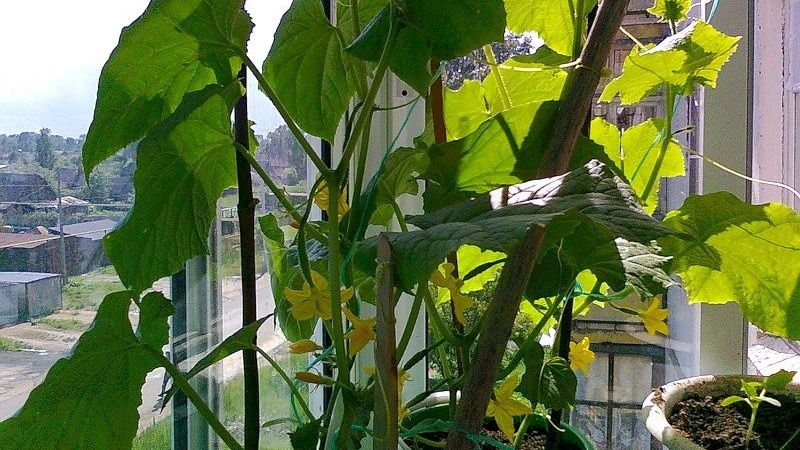
What you will need
When the seed material is prepared, you should select a container for planting, prepare the soil and fertilizer. Creating the necessary microclimate is one of the main conditions for obtaining a full harvest of cucumbers on the balcony.
You can learn about the best varieties of yellow tomatoes for a greenhouse. read here.
What to grow in
Various boxes, pots or flowerpots can be used as containers for growing crops. The larger the vessel, the better for the plant. A larger container will hold more soil and, accordingly, will retain moisture longer. But you should not allow excess moisture - this is harmful to the roots. To avoid waterlogging, care should be taken to ensure reliable drainage.
It is advisable to use containers that retain heat well, for example, black plastic boxes or pots. It is convenient to grow cucumbers on the balcony in hanging pots, trimmed five-liter bottles or flowerpots.
On a note. If another plant previously grew in the container, it should be thoroughly cleaned before use. Old containers may contain pathogenic bacteria from previous seedlings that can harm the crop.
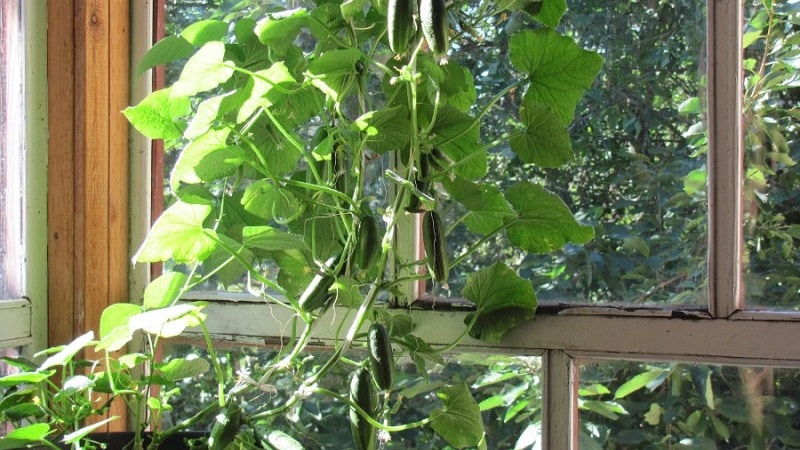
Required materials and tools
To grow cucumbers you will need the following tools and materials:
- seed;
- manganese for disinfection;
- saucer;
- cotton fabric;
- growth stimulating drug;
- container for landing;
- priming;
- fertilizers;
- water for irrigation;
- polyethylene film;
- climate control system;
- phytolamps (if necessary);
- a set of tools for indoor plants;
- supports and threads for tying.
Location requirements
The best place for growing vegetables is considered to be window sills located on the south or southeast side of the house. In this case, the crop will receive the necessary amount of solar heat and light.
On a note. Experienced vegetable growers install a climate control system when growing cucumbers on the balcony. If this is not done, the first young shoots may die from night frosts.
To save useful space indoors, you can use flower containers to plant cucumbers. Such containers have compact dimensions: the minimum width is 15 cm, while the product can reach 85 cm in length. Do not forget about the presence of drainage holes to drain excess water; they are easy to make yourself.
How to grow cucumbers on the balcony: instructions
To protect plants from drafts or sudden changes in temperature, place containers in a glazed and insulated balcony or loggia. If necessary, install phytolamps for additional heating (if the duration of natural light is insufficient).
Germination of seeds
There should be no dark spots or signs of rot on the planting material. Good seeds are smooth, flat-convex, yellowish-white in color and odorless.If the grains from the package are green or another color, this means that they have been treated with a special preparation against diseases and pests. Seeds are planted both dry and germinated. Before germination, place the seed in a 1% solution of potassium permanganate for 20-30 minutes for disinfection.
Then rinse the seeds with water, place them on damp cotton material and cover with it. Place the plate with the soaked seeds in a warm place with a temperature of about 23°C, periodically wet the material, preventing it from drying out. After two days, the seeds will germinate and be ready for planting. Before this, moisten the material with a growth stimulator (Zircon or Epin) 1-2 hours before. Plant dry cucumber seeds a little earlier than expected, as they sprout later.
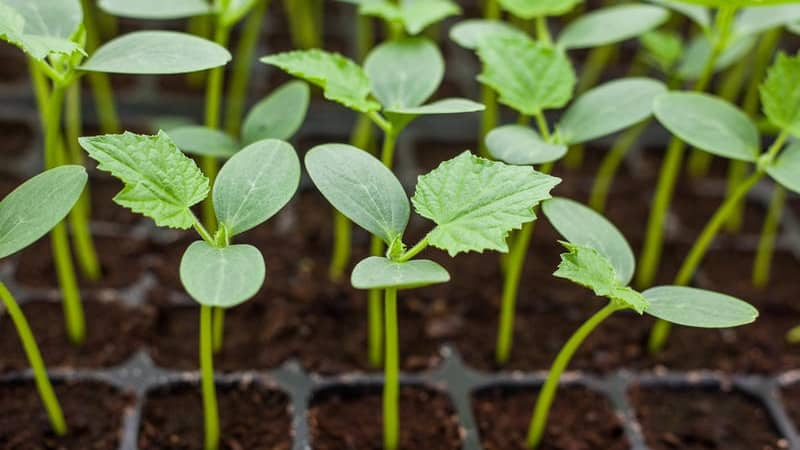
Preparing containers and soil
Before planting, it is necessary to resolve issues with containers and soil.
Plant seed material in disposable plastic cups. Peat cups are sold, from which seedlings do not need to be transplanted into the ground. After some time, the walls of the container collapse and mix with the soil. But such preparations are not suitable for an early ripening plant, since the root grows faster than the peat dissolves in the soil.
Cucumber roots love free space, so grow adult plants in 5-liter bottles, ideally 10 liters. For growing indoor crops, buckets or large pots are suitable, taking into account the fact that one plant will grow in one container.
Vegetables are sensitive to the soil: it must be loose, fertile and fertilized. To create a balcony bed, a purchased universal soil for vegetables or flowers is suitable. Dry peat soil is also used, but it needs to be enriched: mix black soil with humus and fine sawdust. To make the soil looser, mix it with river sand, vermiculite or perlite.
Ash is considered a good soil admixture (0.3-0.4 l per 10 l of soil). Use superphosphate or potassium sulfate as fertilizer.
Growing seedlings
Before planting the hatched seeds, water the soil with a slightly pink solution of potassium permanganate. Plant the seeds to a depth of 1-1.5 cm, sprinkle with soil, lightly moisten with a sprayer and cover with polyethylene. Containers should be in a warm place at a temperature of 23-25°C.
Transplantation and further care
Pour the prepared soil into each container. If the sprouts have sprouted, it means it’s time to move the seedlings to a permanent place of growth, lightly compacting and moistening the soil.
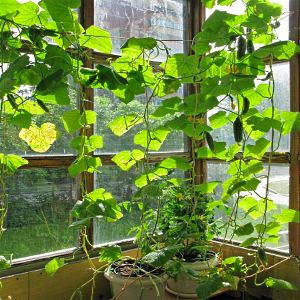 Replant the seedlings that have sprouted in plastic cups together with a lump of earth. To do this, fill the plant with warm water, then push the lump of earth through the drainage hole with your index finger and carefully pull it out. Distribute the seedlings throughout the container at a distance of 35-40 cm from each other.
Replant the seedlings that have sprouted in plastic cups together with a lump of earth. To do this, fill the plant with warm water, then push the lump of earth through the drainage hole with your index finger and carefully pull it out. Distribute the seedlings throughout the container at a distance of 35-40 cm from each other.
Step-by-step plant care:
- To form a lash, do pinching;
- remove the antennae every 10 days;
- to maintain normal humidity levels, spray the soil if it dries out;
- loosen the soil;
- Feed the plants with potassium and phosphorus fertilizers once every two weeks;
- Tie the lashes regularly.
Disease and pest control
A crop that is grown at home is much less sick than plants growing in a greenhouse or open ground. But even in the home it is impossible to eliminate the risk of diseases.
Factors that contribute to their appearance:
- watering with cold water;
- violation of humidity and air temperature;
- planting in contaminated soil;
- insufficient quality preparation of containers.
Powdery mildew is the most common fungal disease. The disease is easy to identify when examining the plant: a white coating appears on the leaves, as if they had been sprinkled with flour. Control measures must be taken immediately, otherwise the entire crop will die. All infected parts of the plant must be removed and the soil disinfected. If the disease develops strongly, treat the crop with an insecticide, for example, Bayleton.
Antactosis manifests itself not only on the leaves, but also on the fruits: the foliage becomes covered with brown spots, which leads to its fragility, and ulcers form on the fruits. The disease is incurable. A bad plant should be removed so that the disease does not spread to healthy cucumbers. For prevention, use a 1% solution of Bordeaux mixture.
Root rot affects both adult plants and young seedlings. The disease is not detected immediately, since the roots rot first. Infection from the roots rises up the stem and then becomes noticeable. The disease cannot be treated - the plant will have to be destroyed. To prevent the crop from becoming infected, the seeds must be disinfected before planting, and it is recommended to steam the soil.
Sclerotinia, or white rot, appears as a white coating on leaves and stems. It is somewhat reminiscent of cotton wool, which turns into mucus. White formations must be removed, then the affected areas should be sprinkled with lime. Sclerotinia appears on the plant due to very humid air on the balcony, so be sure to ventilate the room after watering.
Gray rot affects leaves, flowers and fruits.The gray coating becomes dark and wet over time. The disease must be dealt with in the same way as white rot. The disease appears due to the use of cold water for irrigation and excessive humidity on the balcony.
For your information. During the growing season, to prevent diseases and pests, spray cucumbers with Fitosporin.
Small insects and other pests are also possible:
- Most often, cucumbers are affected by spider mites. He appears under the foliage, spinning a web there. It is by this that the pest is identified. Affected leaves begin to turn yellow, dry out and die. Get rid of spider miteOr you can use onion infusion: add 200 g of crushed onion to 10 liters of water or garlic, let it brew for a day, then spray the plant. The pest starts from very dry air. To moisturize, place a bucket of water on the balcony.
- Aphids are insects that reproduce quickly. At the beginning of its appearance, it is not easy to notice: the length of the parasite is only 2 mm. What to do in this case? Unfortunately, pests are identified only when there are too many of them. When aphids appear, the leaves and stems dry out. A strong concentration of tobacco decoction helps against parasites: boil tobacco in 1 liter of water for 10 minutes, let it cool and add another 1 liter of water before the procedure. Spraying the leaves destroys the entire colony.
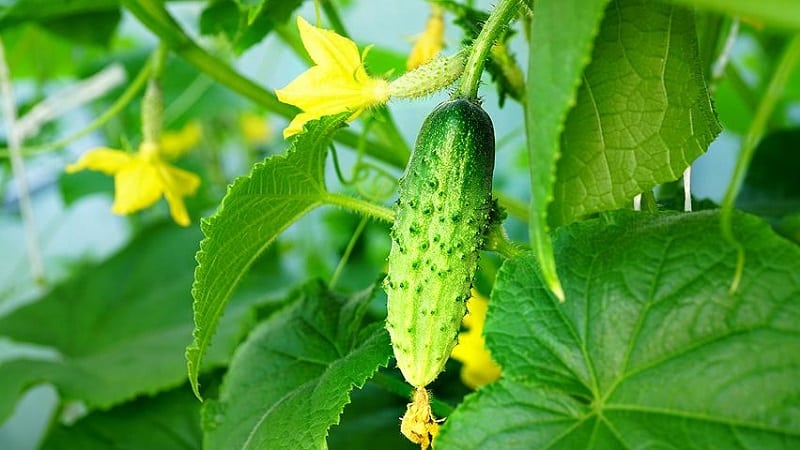
Tips and tricks
Every novice vegetable grower can cope with cultivating cucumbers in a city apartment. The main thing is to follow the rules for growing them on a balcony:
- The culture needs sufficient moisture. To do this, spray the plants or place a wet cloth on the radiator.
- Growing early varieties requires favorable conditions. Insulate the crop, provide it with light and ventilation.
- When the ovaries appear, the plants need supports for the vines. You can make them from wooden sticks.
If you take these points into account, a good harvest will not take long to arrive.
How to pickle cucumbers with basil read here.
Conclusion
Growing window and balcony cucumbers is not difficult. The main thing is to choose a suitable variety, provide the crop with a normal microclimate, do not forget to feed the plant, water it regularly and tie it up. It is also worth checking the window bed from time to time for diseases and pests, promptly identifying and eliminating the infection. This method is quite simple, and if you follow all the recommendations, you will get a good harvest all year round.